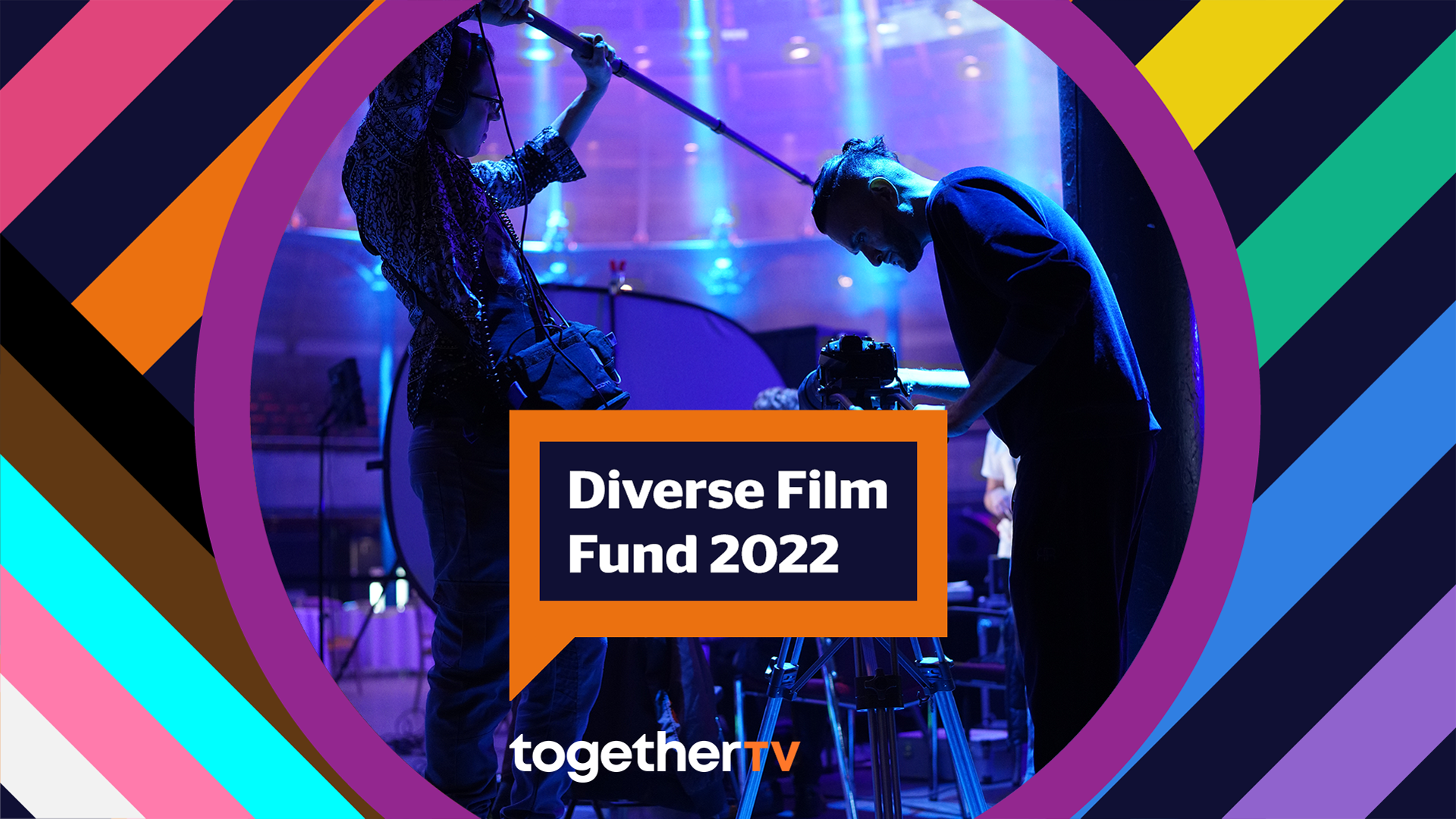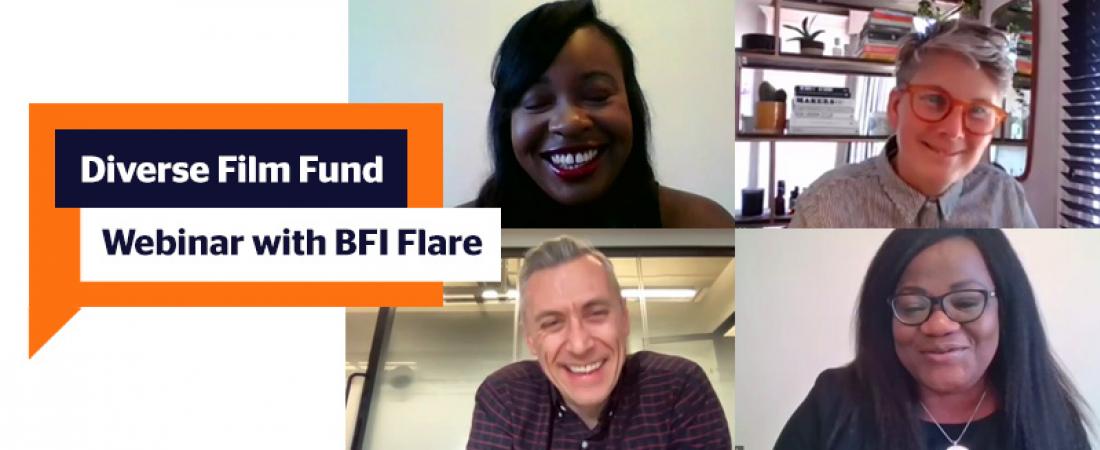Key takeaways from Together TV’s 2022 Diverse Film Fund webinar with BFI Flare
BFI Flare co-hosted a webinar with us to discuss Together TV’s Diverse Film Fund, representing diversity in film and TV, and a Q&A for applying for the fund. Together TV’s Diverse Film Fund is an incredible opportunity for emerging filmmakers to create a short documentary reflecting diverse communities. The 2022 theme is Queer Lives Today, and we are offering £20,000 to five filmmakers to create their short doc as well as mentoring and a TV broadcast. The deadline to submit applications for the Diverse Film Fund is midday 31st March 2022. Get your applications in ASAP; more information and the application form is available here.
The live webinar with BFI Flare was hosted by Together TV’s Janet Olaofe, and the speakers were:
-
Janet Olaofe - Head of Content and Scheduling at Together TV
-
Kit Morey - Commissioning Unscripted Editor (VP) at Channel 5 / Paramount +
-
David Clews - Creative Director at Twofour
-
Sheila Kayuma - Diverse Film Fund alumni, director and producer of “The Black Equestrian”
Key Takeaways
The importance of inclusivity and diversity in filmmaking
Our panellists shared that when casting for films and TV shows, they want to make sure there is a well-rounded representation of contributors, but that underrepresented people are not being shown solely for political reasons, but are there because they are ordinary people.
There were almost no gay characters on TV in the 1980s, as David and Kit mentioned, and if there were they were negative representations. The TV and film industry has advanced since then, but it still has a long way to go which is why Together TV is doing its part in giving diverse voices the chance to be heard.
One of the best ways to tell stories is to use heart and humour. Even though people’s stories can be serious, you want your audience to come to the film and be willing to take something from it without forcing it upon them.
One example of LGBTQ+ people in everyday media is how one of the couples on The Great Model Railway Challenge was trans. They weren’t there because they were part of the LGBTQ+ community, but because they built model railways. Showing underrepresented people within mainstream media allows a wider audience to meet them.
Within the LGBTQ+ community there is so much incredible diversity. No one is simply LGBTQ+, there are innumerable assets that make up a single person, and being mindful to depict someone as a developed character is important. The attendees were reminded that films and TV shows should be accepting and understanding of all identities and to be mindful of that when making their documentaries.
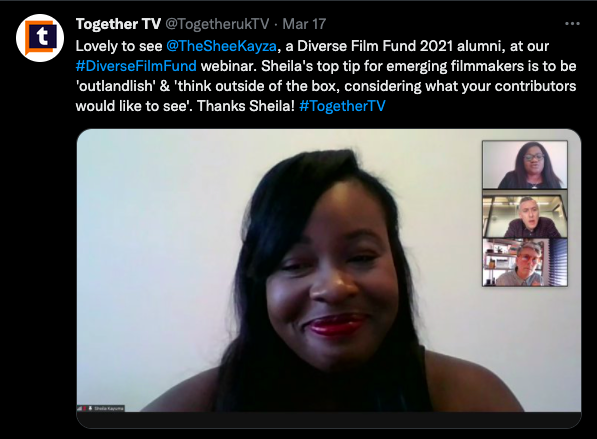
Think outside the box
Our Diverse Film Fund alumni, Sheila Kayuma, emphasised the importance of thinking outside the box when it comes to a film’s story and contributors. She thought about stories that she hadn't seen represented on TV before and decided to explore that. “The Black Equestrian'' showcases Black people in a sport that is majority white and isn’t common. When figuring out what story to tell and film to make, it is important to consider how someone might be occupying a space that you wouldn’t expect.
The mentorship opportunity through our Diverse Film Fund allows filmmakers to bounce ideas off of a professional in the film and TV industry. Sheila said that the whole experience with Together TV’s Diverse Film Fund was a massive learning curve, but the support and amount of information given was so valuable.
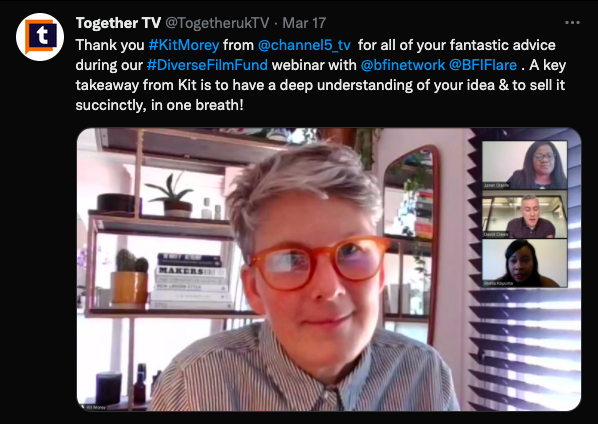
Find the simple line in your story
The Diverse Film Fund’s goal is to give inspiring and diverse ideas for films funding, so the filmmaker needs to have a sharp focus on the simple line of their story so they can easily communicate it to others. As the filmmaker, you want to simplify the story down to its essence at the beginning and look for what you, the filmmaker, want to say.
Once you have an understanding of the story, you can explore what the narrative will be. You should think about what kind of documentary you want to make. Does it have an active storyline or is it retrospective? He also opened the question of what are the other ways you can tell a story that doesn’t make it overly political, but shows your point with humour.
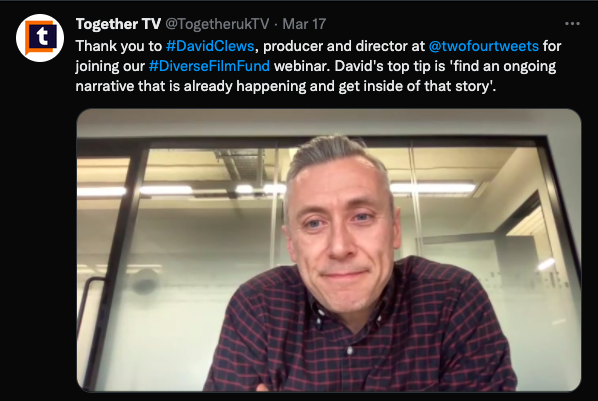
Take us on an emotional journey
As simple as it is, you want a beginning, middle, and an end to your film’s story. We know the beginning and often know where we want to end. But the middle part of the film is most important and often the hardest to create. Ask yourself what is the figurative and literal story arc of your character? This includes all the highs, lows, lights, darks, and shades. Just like a narrative movie like Star Wars or The Avengers, a documentary needs to bring its viewer on an emotional journey. You don’t want a film that will plateau, it needs those emotional points where it spikes and we laugh and where it drops and our heart strings are tugged.
It is also importnat to ask 'where am I going to take this story' at the beginning? As a filmmaker pitching your idea to a funder, you need to understand what you’re trying to sell. So have that simple line through and trust those around you including your mentors to help guide you on your journey and see things in your storyline that you may not have noticed at first.
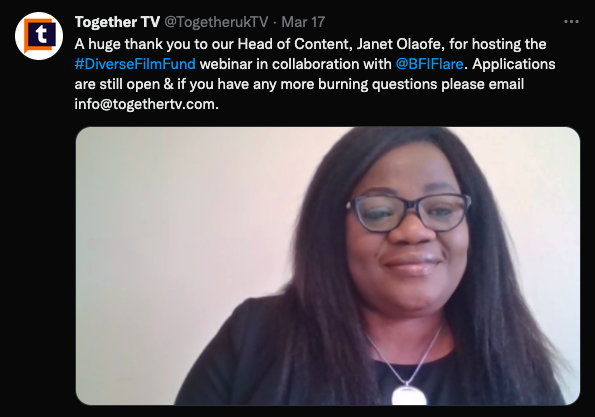
Q&A
Q: How can we best put our vision for the film across visually?
KM: If it were to be a show reel, like a taster tape or something, I would say try and keep that tape relatively short, two and a half minutes, three minutes. Which is a good discipline for the succinctness that we've spoken about. Visuals may be like a mood board. You can think about what the backdrop to your film is. Is there a location that is a particularly strong part of where you're setting your piece? It's a visual medium so think about what you’re gonna feel when you see that imagery? Draw the person that you're selling it to as quickly as possible and as visually as possible.
DC: You can cut a sort of taster tape using found footage, so basically taking things off youtube or other footage and archive, and put a number of slates in. It's trying to put the treatment into a minute and a half sizzle. That can give you the tone of the piece and the style of the piece and explain what the story could be. Try and sell an idea to get the broadcasters excited about it.
Q: What would you advise potential student filmmakers who are studying and trying to apply for this fund should they win?
SK: Get ready for it to be very very challenging. Ultimately, just be sure to not bite off more than you can because your studies are really important, but I think it's very doable if you structure everything that you're doing.
Together TV knew from the start that I was doing my masters at the time, and you guys gave me a lot of support. I also approached my lecturers and let them know what was happening. You can also always reach out if you need help. There's people around you, they're always going to be able to help you.
Q: What is the importance of hiring the right crew?
JO: We always try to make sure that everybody gets the right type of people to help them professionally.
DC: It depends on the story. You have to ask what will the film be built from? If there's footage from a family archive that they've had for a very long time that could be telling a story. It goes to a broader question I guess of how best to spend the money. Be smart about how best to use it. The mentors will be able to help with that sort of thing once you get into the nuts and bolts of how best to make that film.
KM: Hiring crew, getting the right staffing on board, is crucial, but that is something that also comes with experience. When you have a budget, cut your cloth accordingly. I think it's making sure that the coverage of the story is sufficient to get the story and the emotion across on screen. Once you know the story you want to tell, you’ll know the moments in the story that need a particular framing, and you'll know what you need and where the resources are best placed in your schedule. That's all part of the creative process.
Q: What challenges do you think you would face when you're talking about the queer experience with younger people?
DC: There's two parts to this. In my head, being young and queer today feels as though you can talk about it in a way that you couldn't when I was 18, but I'm sure that's a generalisation. I imagine the stories that you'll be attracted to will be complex. Difficult stories can be told and they can be told responsibly, but you then need to question it. It will be out there for the world to see, and you have to ask if it is going to be fine how someone feels now especially when they're young. And will they regret sharing that story in a year's time, in five years time, in 10 years time?
The other big thing that we're always thinking about now is social media. It's all well and good that you protect your contributors when a series goes out on linear telly, but now they're out there permanently and people are really mean. Twitter is really really awful. You can think about making the film in a responsible way and you can help deal with the negativity that people get by sharing their story. The only way to change that negativity is by fighting against it.
KM: Some of the most difficult stories are some of the most important stories to be heard. The duty of care is paramount, but that doesn't mean we shouldn't tell them. That doesn't mean we shouldn't approach stories that are difficult as long as the support and the framework is in place.
I think that what we may find is that there are young people wanting to share a story, and there is one thing to approach when you sit down with a camera. You don't know how you're going to feel either listening to someone talk about something or for that person to talk about something. Being thorough in our approach to the story that's going to be told with all the right support and things in place will be critical.
Q: Last words of advice?
DC: It’s about the clarity of story and the passion; why your individual take on it is important.
KM: What will give the audience the feels? What will make the audience think about what you've told them? What their own life means, what they feel when they look out at the rest of the people on the bus or the people that they know in their families. Empathy and connection, that's what I think television does. It connects us through shared emotion, so I would go for the feels.
Q: How have things changed for you since the project last year?
SK: It's done a lot for me because I now have a broadcast credit, and I've been able to show my film to so many different people. It's unbelievable the reaction that I've had from young people. Not just young Black people, but young people saying ‘oh my gosh I never thought I'd have the confidence to get on a horse, I didn't even think I could do anything like that.’ I’ve had people from Nigeria inboxing me and saying you should come to Nigeria and do a documentary about Nigerian equestrians.
It's just been really overwhelming in that sense, and I really really love the fact that even the people who are already Black equestrians reach out to me and say ‘oh my god no one ever verbalised all the things I've experienced so well.’
One of my contributors is trying to get to the Olympics. She's just been given a horse on loan, and she wants to be the first Black British equestrian for team GB. She's gotten so many opportunities off the back end of the documentary, and for me that is the biggest win of all because it's given somebody a platform that they didn't have before.
Together TV’s 2022 Diverse Film Fund’s application deadline is 31st March 2022, find information and the application here.
